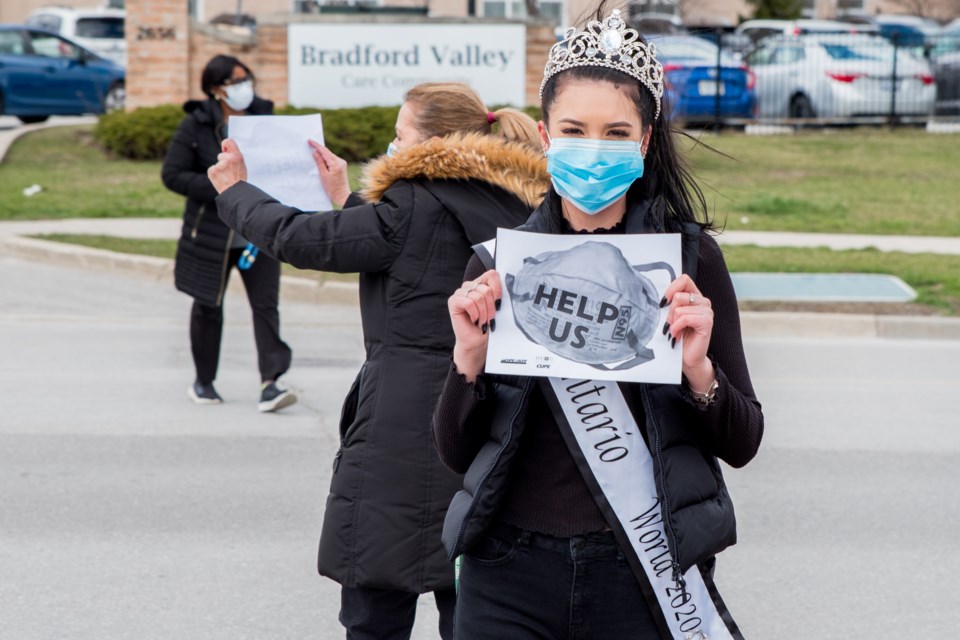Bradford Valley Care Community employees held a protest outside the long-term care facility Thursday afternoon, calling on the government to ensure better protection for healthcare workers.
Over the weekend, an outbreak of COVID-19 was reported at the long-term care facility on Line 6 of Bradford.
To to date, there are 14 residents and three staff members confirmed positive with the virus. All three staff members are self-isolating at home; the residents are isolating at the facility. At present, none have been hospitalized.
The protest seems to have the support of the Ontario Health Coalition.
In a statement sent out this Thursday, the coalition called for better testing, better access to personal protective equipment (PPE), and greater respect for human rights at long-term care (LTC) centres across the province.
"The coalition is deeply concerned that the new measures released by the Ontario government are not enough to stop the spread of COVID-19 into (LTC) homes that currently do not have outbreaks, nor are they enough to stem the outbreaks in existing homes and protect staff," read the statement.
The statement went on to note, "long-term care deaths from COVID-19 now account for almost half of all of Ontario’s deceased, according to the provincial data on infections. The numbers of staff and residents who have tested positive is escalating at a devastating pace. Following an emergency meeting of the Ontario Health Coalition long-term care committee, including family councils, unions, health professionals, seniors’ advocates and experts on long-term care, the Ontario Health Coalition called for more aggressive concrete measures to be implemented as soon as possible."
Anonymous sources, who declined to be identified, expressed concern that masks were not being made available to workers at Bradford Valley as late as last Thursday, just before the COVID-19 cases were identified publicly.
Sienna Senior Living management for Bradford Valley Care Community, queried on the issue, stated that they are following guidelines from the Ministry of Health for Infection Prevention and Control (IPAC) and Occupational Health and Safety (OHS), in providing all employees with masks, and that they had precautions in place prior to the outbreak.
All team members are now provided with a surgical mask at the start of their shift; however only members working directly with COVID-19-positive patients are provided with an N95 mask, the spokesperson said.
"Team members, who perform procedures (such as suctioning) when caring for a resident who is suspected or confirmed with COVID-19, are provided with a respirator, also known as an N95 mask. We continue to follow directives and guidelines issued to us by health units," read a response from management.
Currently, the following policies are in place at the home to help contain the spread of the virus:
- Anyone suspected of being exposed to COVID-19 is quarantined, and confirmed COVID-19 residents are in isolation. These residents are dining in their rooms and no longer participating in group recreational activities.
- Team members are wearing surgical face masks and having their temperature taken twice per shift.
- Twice-daily temperature checks and frequent health monitoring has been instituted for all residents.
- Physical distancing is in place, to the extent possible.
- Rigorous frequent cleaning of all surfaces has been introduced.
- No non-essential visitors. There is also active screening of any essential visitors, which includes temperature checks.
It's not enough, says the Ontario Coalition of Health. With 69 long-term care homes experiencing outbreaks in the province, 347 infected staff and 498 infected residents, and a total of 86 deaths to date, the coalition is calling for the following measures to be instituted by the provincial government:
- All staff must be provided with PPE in accordance with the precautionary principle, including N95 masks for those exposed to residents with suspected or confirmed COVID-19 infection. In addition, staff must be able to access changes of masks and PPE in accordance with the precautionary principle.
- All homes must be provided with training and support, to provide proper training to staff in the use of PPE immediately. There are many homes that do not have the ability to do this themselves.
- All staff, residents, volunteers, families and management going into long-term care homes or residing in long-term care homes must be tested. For families of residents who are in palliative care, compassionate access to their family member should be provided while they are waiting for test results, with proper additional safety measures.
- Deregulation of existing staffing standards and the use of contracted-out, untrained and volunteer labour cannot be the response to the staffing crisis in long-term care, the coalition stated - giving as examples the response in British Columbia and Quebec.
The coalition is now calling for more full-time hours to be offered in long-term care and nursing homes, recruitment of trained staff to improve care levels, and improved wages and working conditions to stabilize the work force.
The current directive, requiring all visitors and staff to wear surgical masks (except on break), is inadequate, the coalition warned — calling for all staff, family, visitors and volunteers at the homes be tested as soon as possible. The coalition also questioned whether all long-term care homes are able to provide the level of isolation demanded by provincial standards.
"We are concerned because this is not practically possible in many long-term care homes. Some of the newer homes may be able to follow this directive, but many homes simply have no way of doing this. The government must come up with a better solution to protect residents and staff and stop the spread of COVID-19 in the homes," read the statement.
Meanwhile, staff members at Bradford Valley carried signs and chanted, "We want N95" as they stood outside the gates. On the front lines, they feel under-protected and exposed to the risk of COVID-19, and worry about the residents — Bradford's most vulnerable citizens.



